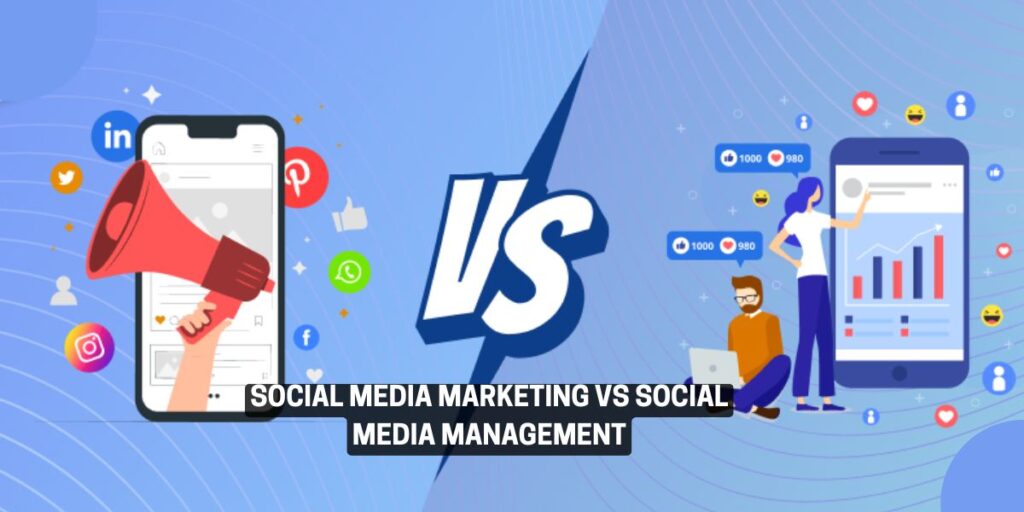Social media marketing vs social media management—two roles every business needs for a strong online presence, yet often confused. In this post, I’ll unpack
Social Media Marketing vs Social Media Management,
explain how they overlap, and give practical steps to use both so your brand doesn’t just show up — it wins.
Social Media Marketing — Strategy, Growth & Campaigns
Social Media Marketing
is the growth engine: it’s the strategic use of platforms (Facebook, Instagram, LinkedIn, TikTok, X) to reach business goals like brand awareness, lead generation, website traffic, or sales. Think campaign planning, paid ads, content strategy, influencer partnerships, and conversion funnels.
Why it matters:
- It defines why you’re on social and links social activity to business KPIs (awareness, leads, revenue). HubSpot’s teaching and certification resources are full of frameworks that map social activities to measurable goals.
- Marketing involves creative strategy (audiences, messaging), paid media (ads), and analytics to measure ROI — the parts that drive growth, not just day-to-day posting. Hootsuite’s overview of social strategy highlights how campaigns and content types differ by objective.
Common social media marketing tasks:
- Audience research and persona mapping
- Paid social campaigns and A/B testing
- Content calendars tied to promotions or launches
- Tracking conversion metrics and attribution
Social Media Management — Operations, Community & Tools
Social media management keeps the engine running. It’s the day-to-day operational work: scheduling posts, responding to comments and DMs, community moderation, monitoring brand mentions, and using management tools to keep accounts organized and compliant.
Key points:
- Management is about how you publish and engage consistently, and it often uses specialist platforms (Hootsuite, Sprout Social, Buffer, HubSpot Social Inbox) to schedule, listen, and report. These tools are explicitly built for the operational side of social.
- A strong social media manager balances community care (real-time replies, crisis flagging) with maintaining brand voice and meeting posting SLAs. HubSpot’s social inbox and reporting examples show how management connects activity to pipeline reporting when integrated with CRM.
Common social media management tasks:
- Scheduling and publishing across platforms
- Community management (answers, moderation)
- Social listening and mention tracking
- Reporting on engagement, response times, and post reach
The Relationship Between Them — How They Work Together
Now for the good part: social media marketing vs social media management isn’t an either/or. Think of marketing as the blueprint and management as the construction crew.
How they interact:
- Marketing sets the campaign goals and content pillars (e.g., “drive webinar signups”); management executes the plan, schedules posts, and handles on-the-ground engagement. This split keeps strategy focused and execution consistent.
- Data flows both ways: management reports (what content resonated, what customer pain points surfaced) inform future marketing strategies and creatives. Tools like Sprout and Hootsuite highlight how analytics and listening feed strategy.
Practical teamwork tips:
- Create a shared content calendar that ties posts to marketing campaigns.
- Define SLAs: who replies to DMs, who escalates complaints, and what counts as a campaign win.
- Use unified dashboards (or CRM integrations) so both teams share one source of truth for metrics.
Who Should Own What? (Quick Role Guide)
- CMO / Marketing Lead: Owns strategy, budgets for paid social, campaign success metrics.
- Social Media Manager: Owns daily publishing, community, scheduling tools, moderation.
- Content Creator / Designer: Produces assets to fulfill the marketing roadmap.
- Analyst: Tracks multi-channel attribution and ties social activity back to revenue.
Measuring Success — KPIs That Matter
For social media marketing: conversion rate, cost-per-lead, ROAS for paid campaigns, growth in qualified leads.
For social media management: engagement rate, response time, sentiment, follower growth, content reach. Use both to prove impact — operations + strategy = sustainable growth.
Quick Checklist: Aligning Marketing + Management
- Have a monthly strategy sync (campaigns, learnings, calendar).
- Share access to the same analytics dashboards and UTM conventions.
- Establish crisis and escalation protocols.
- Run periodic A/B tests and let management surface what’s actually working in real conversations.
Final Thoughts
When people argue social media marketing vs social media management, the real answer is: you need both. One fuels growth with strategy and paid assets; the other delivers consistency, community care, and operational excellence. Treat them as partners, build shared processes, and your social presence will stop being noisy and start being effective.

